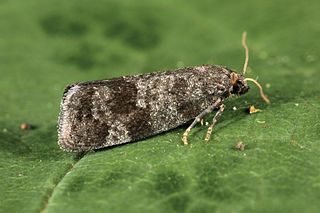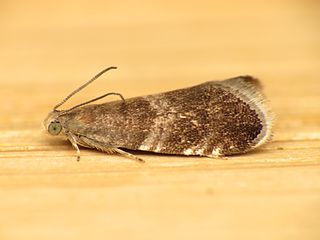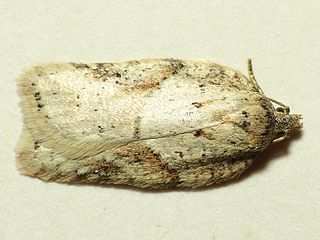
Clepsis spectrana, the cyclamen tortrix, cabbage leafroller or straw-colored tortrix, is a moth of the family Tortricidae. It is found in Europe.

Archips podana, the large fruit-tree tortrix, is a moth of the family Tortricidae. The species was first described by Giovanni Antonio Scopoli in his 1763 Entomologia Carniolica. It is found in Europe, Anatolia and is an introduced species in North America.

Eupoecilia ambiguella, the vine moth, is a moth of the family Tortricidae. It is found in Europe, China, India, Japan, Korea, Mongolia and the Russian Far East.

Epinotia ramella is a moth of the family Tortricidae. It is found in Europe, China, Japan, Russia and Kazakhstan.

Epinotia immundana is a moth of the family Tortricidae. It is found in China (Qinghai), Russia and Europe.

Epiblema scutulana is a moth of the family Tortricidae. It is found in the Palearctic ecozone. The species closely resembles Epiblema sticticana and Epiblema cirsiana, identification is only possible on the basis of microscopic examination of the genitalia.

Celypha rufana, common name lakes marble, is a small moth species of the family Tortricidae, long known under the junior synonym C. rosaceana.

Epinotia solandriana is a moth of the family Tortricidae. It is found in Europe, China, Korea, Japan and Russia.

Spilonota ocellana, the bud moth, is a moth of the family Tortricidae. It is found in the Palearctic ecozone. It is also present on Madeira and in North America.

Neosphaleroptera is a genus of moths belonging to the subfamily Tortricinae of the family Tortricidae. It contains only one species, Neosphaleroptera nubilana, which is found in almost all of Europe and the Near East.

Eupoecilia angustana is a moth of the family Tortricidae. It is found in most of Europe to the southern part of the Urals, China, Japan and Korea.

Aethes smeathmanniana, or Smeathmann's aethes moth, is a moth of the family Tortricidae. It was described by Johan Christian Fabricius in 1781. It is found in most of Europe, Asia Minor and in North America, where it has been recorded from New Jersey and Newfoundland and Labrador.

Epinotia nisella is a moth of the family Tortricidae which is found in Asia, Europe and North America. It was first described be Carl Alexander Clerck in 1759.

Hedya ochroleucana, the buff-tipped marble or long-cloaked marble, is a moth of the family Tortricidae. It is found in most of Europe, except part of the Balkan Peninsula and Ukraine. It is also present in most of North America.

Aethes rubigana, the burdock conch, is a moth of the family Tortricidae. It was described by Treitschke in 1830. It is found in most of Europe, except the Iberian Peninsula and part of the Balkan Peninsula. Outside of Europe, it is found in China, Japan and Russia.

Strophedra weirana, the little beech piercer, is a moth of the family Tortricidae. It is found in most of Europe, except the Iberian Peninsula, part of the Balkan Peninsula, Ukraine, the Baltic region, Finland and Ireland.

Acleris logiana, the black-headed birch leaffolder moth or grey birch button, is a moth of the family Tortricidae. It was described by Carl Alexander Clerck in 1759. It is found in most of Europe, except Ireland, Portugal, most of the Balkan Peninsula and Ukraine. It is also found in North America, the Russian Far East, Korea and Japan.

Eucosma cana, the hoary bell, is a species of moth of the family Tortricidae.
Epinotia subocellana is a species of moth of the family Tortricidae. It is found in Asia and Europe and was first described by Edward Donovan in 1806.

Epinotia abbreviana is a moth of the family Tortricidae. It is found in Europe and was first described by Johan Christian Fabricius in 1794.



















